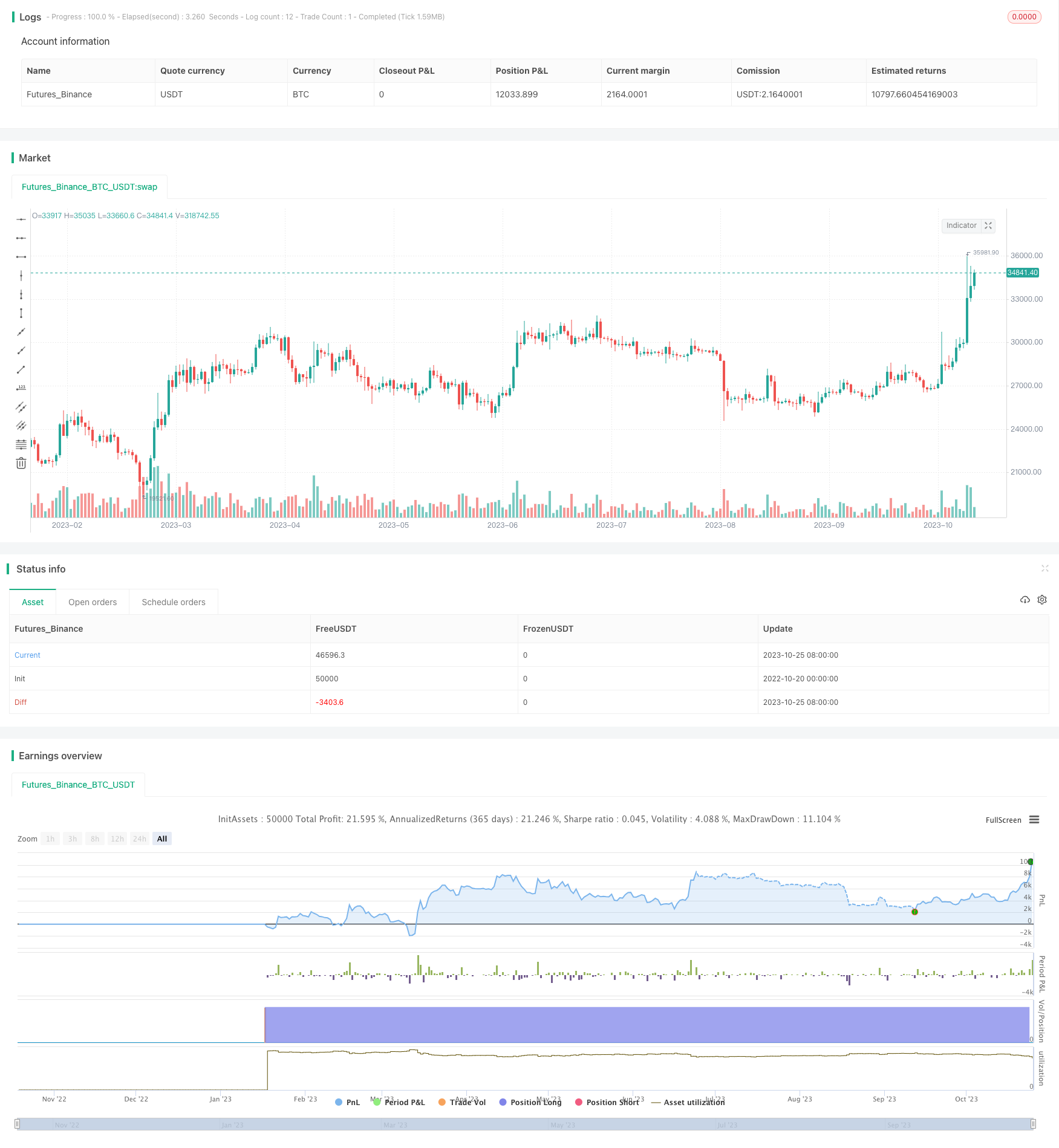
概述
Ichimoku Kumo Twist策略利用Ichimoku指标的转换线、基准线和导线构建交易信号,属于趋势跟踪策略。它通过Ichimoku云带的扭转寻找短期和中期趋势的反转点,以获取较低风险的突破点位和超买超卖机会。该策略既可用于日内交易,也可用于持仓数周的中长线交易。
策略原理
该策略主要使用Ichimoku指标的三条均线 - 转换线、基准线和导线1,以及K线的最高价和最低价计算云带上下界。转换线计算过去9根K线的最高价和最低价中点,代表一目均衡图的短期均线;基准线计算过去26根K线的最高价和最低价中点,代表长期均线。导线1为转换线和基准线的平均线,导线2为过去52根K线的中点价。
当导线1上穿导线2时产生买入信号,而导线1下穿导线2时产生卖出信号。该交易策略就是追踪短期和中期均线的金叉死叉,以捕捉趋势的变化。
优势分析
Ichimoku云带扭转策略同时结合短期和中期趋势,可以有效识别趋势反转点。
基于均线的策略,具有一定的滞后性,可以过滤掉部分噪音。
利用云带判断强弱趋势的明显程度,实现较优的 entries 和 exits。
无需参数优化,使用 Ichimoku 标准参数即可。
风险分析
Ichimoku原理比较复杂,对参数调整不敏感,不易过度优化。
在盘整市场中,可能出现多次错误信号。
当短期和中期趋势背离时,会出现策略失效的情况。
必须搭配止损来控制风险,否则可能造成较大亏损。
优化方向
可以测试转换线和基准线的不同参数组合,找到最佳平衡点。
结合其他指标过滤入场信号,避免在明显不利形态中建仓。
增加止损策略,设置动态止损或尾随止损。
优化仓位管理,根据市场情况调整仓位规模。
在回测中加入交易手续费,使回测结果更准确。
总结
Ichimoku云带扭转策略整体来说是一种适中的趋势策略。它可以有效识别趋势转折点,在符合趋势的方向打开头寸。但该策略也存在一定监控成本,必须搭配严格的风险管理措施才能长期使用。通过不断优化参数设置、入场过滤器、止损方式等,可以继续提高该策略的稳定性和盈利能力。
/*backtest
start: 2022-10-20 00:00:00
end: 2023-10-26 00:00:00
period: 1d
basePeriod: 1h
exchanges: [{"eid":"Futures_Binance","currency":"BTC_USDT"}]
*/
//@version=3
strategy(title="Ichimoku Kumo Twist Strategy (Presets)", shorttitle="Kumo Twist Strategy", overlay=true)
xlowest_(src, len) =>
x = src
for i = 1 to len - 1
v = src[i]
if (na(v))
break
x := min(x, v)
x
xlowest(src, len) =>
na(src[len]) ? xlowest_(src, len) : lowest(src, len)
xhighest_(src, len) =>
x = src
for i = 1 to len - 1
v = src[i]
if (na(v))
break
x := max(x, v)
x
xhighest(src, len) =>
na(src[len]) ? xhighest_(src, len) : highest(src, len)
dropn(src, n) =>
na(src[n]) ? na : src
ichiConversionPeriods(presets) =>
if presets == "Crypto Doubled"
20
else
if presets == "Crypto Singled"
10
else
if presets == "Standard Doubled"
18
else
9
ichiBasePeriods(presets) =>
if presets == "Crypto Doubled"
60
else
if presets == "Crypto Singled"
30
else
if presets == "Standard Doubled"
52
else
26
ichiLaggingSpan2Periods(presets) =>
if presets == "Crypto Doubled"
120
else
if presets == "Crypto Singled"
60
else
if presets == "Standard Doubled"
104
else
52
ichiDisplacement(presets) =>
if presets == "Crypto Doubled"
30
else
if presets == "Crypto Singled"
30
else
if presets == "Standard Doubled"
26
else
26
scaling = input(title="Scaling", options=["Linear", "Log"], defval="Linear")
presets = input(title="Presets", options=["Crypto Doubled", "Crypto Singled", "Standard Doubled", "Standard Singled"], defval="Crypto Doubled")
dropCandles = input(1, minval=0, title="Drop first N candles")
showClouds = input(false, "Show Clouds")
stoploss = input(true, title="Stop Loss")
conversionPeriods = ichiConversionPeriods(presets)
basePeriods = ichiBasePeriods(presets)
laggingSpan2Periods = ichiLaggingSpan2Periods(presets)
displacement = ichiDisplacement(presets)
logScaling = scaling == "Log"
lows = dropn(low, dropCandles)
highs = dropn(high, dropCandles)
lowsp = logScaling ? log(lows) : lows
highsp = logScaling ? log(highs) : highs
donchian(len) =>
avg(xlowest(lowsp, len), xhighest(highsp, len))
conversionLine = donchian(conversionPeriods)
baseLine = donchian(basePeriods)
leadLine1 = avg(conversionLine, baseLine)
leadLine2 = donchian(laggingSpan2Periods)
golong = crossover(leadLine1, leadLine2)
goshort = crossunder(leadLine1, leadLine2)
strategy.entry("Buy", strategy.long, when=golong, stop=(stoploss ? high+syminfo.mintick : na))
strategy.entry("Sell", strategy.short, when=goshort, stop=(stoploss ? low-syminfo.mintick : na))
conversionLinep = logScaling ? exp(conversionLine) : conversionLine
baseLinep = logScaling ? exp(baseLine) : baseLine
leadLine1p = logScaling ? exp(leadLine1) : leadLine1
leadLine2p = logScaling ? exp(leadLine2) : leadLine2
plot(showClouds ? conversionLinep : na, color=#0496ff, title="Conversion Line")
plot(showClouds ? baseLinep : na, color=#991515, title="Base Line")
p1 = plot(showClouds ? leadLine1p : na, offset = displacement, color=green, title="Lead 1")
p2 = plot(showClouds ? leadLine2p : na, offset = displacement, color=red, title="Lead 2")
fill(p1, p2, color = showClouds ? (leadLine1p > leadLine2p ? green : red) : na)